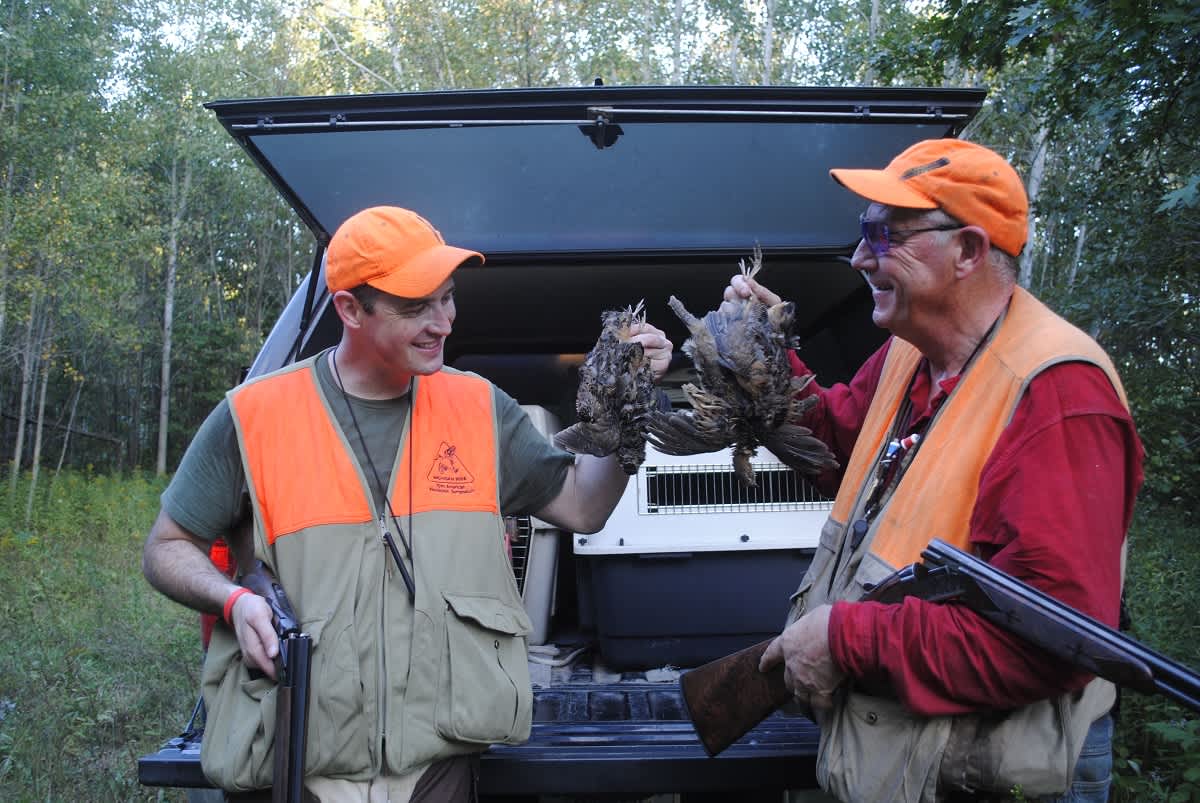An Early-season Michigan Upland Hunting Excursion
Bob Gwizdz 10.06.15

The plan had been to be in the woods near Gladwin by 8 a.m., but it had been raining all morning and was still raining hard enough that it made sense to linger over coffee. There’s no doubt we were going to get wet; if you’re hunting grouse and woodcock after a rain and you are not getting wet, you are clearly in the wrong habitat. But there’s no sense in making it any worse than it has to be, eh?
As it turned out, we were in the woods only an hour later. Though the rain had stopped, all three of us—Al Stewart, his son Chris, and your humble correspondent—were soaked to the skin within minutes.
We were hunting familiar territory that seems to always have at least some birds in it and this year proved to be no exception. Within minutes we were putting up birds. But many more were heard than seen, which is not all that unusual in mid-September in the Michigan grouse woods.
Our first leg of the morning produced 10 flushes—six grouse and four woodcock. All three of us had a chance. I shot at a woodcock that gave a window so narrow that Olive Oyl couldn’t have slipped through it without sucking in her breath. I missed. (Why even bother taking low-percentage shots? Because if you don’t shoot, there’s 100 percent chance you’re not going to get it.)
Both Stewarts had shots at grouse. Chris had an iffy look. And Al? I saw the bird. It was a shot that Stewart never misses, but somehow did.
“I already had that bird in my game bag before I raised my shotgun,” he said. It happens.
We went to an area that was a lot younger (judging by the aspens, I’d say it had been cut six or seven years ago, excellent woodcock habitat) and found more birds. Seventy-five minutes later, having moved four grouse and 14 woodcock, we emerged with one timberdoodle in our game bags, a bird that flushed right at my feet, towered, and I dusted with load on No. 8s, just as it crested over the aspens. Birds 27, hunters 1.
As we worked our way back along the roadway, Chris’s setter jumped back into the woods and went on point. Chris went in after it. The woodcock flushed and flew in the only direction we could get a shot at it and I killed it. Birds 27, hunters 2. Things were looking up.
The temperature was rising. The dogs needed a blow. We repaired to a nearby eatery for a hamburger and discussion.
The grouse numbers, so far, weren’t bad. We knew that we weren’t very far from the trough in the population cycle, so moving three birds an hour is good. And 19 woodcock? I found it rather encouraging.
Stewart said he’d been getting some reports of good woodcock numbers from guys who were out and about during the early days of grouse season (woodcock season opened four days after grouse season this year) as well as some reports from field biologists who said they saw a lot of birds in areas where that wasn’t always the case. They wondered if the birds had begun migrating earlier than usual this year, but there’s no reason to assume so as we really hadn’t had any weather to speak of. The guess here is that there was just good woodcock production this year, which is a good thing, given the birds have been in long-term (say, four or five decades) decline across North America.

After lunch, we went to a couple of covers that had long been among our favorites in this area—places that produced fair to good numbers of both woodcock and grouse in the past—and came away with nothing. We flushed a few woodcock in areas where we’d killed limits—low-lying, mostly alder stands that were thicker than Irish accents—but got no shooting.
What was interesting to note was how heavy the grass was in these areas. Whether that had to do with the wet spring or not, I don’t know, but Stewart pointed out that while woodcock thrive in woodlots with heavy stem density, the important consideration is overhead cover, not ground cover. Woodcock like to be able to see around them; ever notice how large their eyes are and how they are positioned in their heads? Thick grass is not helpful.
With about an hour of shooting time left, we returned to vicinity of our second leg (we hadn’t hunted it all) where we’d found the most birds and by far the most woodcock. It turned out to be the best leg of the day.
Rub, my setter, was gassed. I gave him the rest of the day off. So I took the middle while the Stewarts flanked me with their setters—and we started putting up birds.
It was tough shooting, but both Stewarts killed birds: Al killed a grouse and two woodcock. Chris killed a pair of timberdoodles.
All told, we moved 58 birds; 44 woodcock and 14 grouse. Good numbers. In a couple of weeks—when the leaves are down—there should be some pretty good bird hunting in the Michigan woods this fall.
For more information on Michigan hunting go to michigan.org. Click here to purchase a Michigan hunting license online.
This article was produced in partnership with Pure Michigan.

